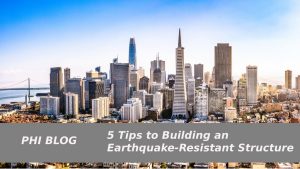Natural disasters are sudden and dangerously powerful, making them a serious threat to communities nationwide. Professionals have learned to anticipate some like hurricanes, blizzards, and tornadoes, but others can still strike with no warning. Earthquakes of any magnitude can occur at any time of the year with almost no indications. They can affect small remote areas, or destroy large cities. Experts have discovered specific U.S. areas highly prone to earthquakes, but technically they could happen anywhere. In a country brimming with permanent steel, glass, and concrete structures, earthquakes possibly pose the greatest threat of widespread destruction.
The Federal Emergency Management Agency (FEMA) works in cooperation with the National Earthquake Hazards Reduction Program (NEHRP) to research and design structural building practices and regulations to protect against earthquakes. Their goal is to minimize damage and injury through a building’s structural integrity. The FEMA and NEHRP safety professionals work with engineers and architects to identify building characteristics that directly affect a building’s behavior during shakes and vibrations.
Why Earthquake-Resistant Structures?
Earthquakes are defined as rapid shaking of the ground caused by the shift of rock and tectonic plates underground. The ground seems solid, but the upper crust of the earth is deep and long periods cause pressure to build up between plates and fissures. When the pressure gives, seismic vibrations and violent shaking reverberate to the surface, immediately affecting miles of land. After the initial quake, aftershocks can occur resulting in further damage.
Earthquakes can virtually happen anywhere. The buildings may have to endure radical movement and foundation shifts in order to minimize damage and protect the people inside and around them. If the fracture or collapse, no emergency plan can protect the people from harm. Earthquake-resistant building designs consider the following characteristics that influence their structural integrity: stiffness and strength, regularity, redundancy, foundations, and load paths.
Stiffness and Strength
When designing earthquake-resistant buildings, safety professionals recommend adequate vertical and lateral stiffness and strength – specifically lateral. Structures tend to handle the vertical movement caused by quakes better than the lateral, or horizontal, movement. Without considering earthquakes, professionals still focus on a building’s vertical stiffness and strength as it has to support itself. However, earthquakes introduce new directional forces that may not be prepared for. Buildings will shift left and right during the event, and, if not built properly, will quickly destabilize.
Regularity
This characteristic refers to the movement of the building when pushed in lateral directions. Safety professionals and building designers want the building to move equally so as to dissipate the energy without placing too much force on one side or another. If a building is irregular, then weaknesses will become apparent when the building sways. The weakness will compromise and the structure will see concentrated damage – which compromises the structure as a whole.
Redundancy
Possibly one of the most important safety characteristics when designing for safety, redundancy ensures there are multiple strategies in place in case one fails. These can potentially add to the building cost, but redundancies prove their worth if/when a natural disaster such as an earthquake occurs. Safety professionals advise equally distributing mass and strength throughout the structure so strength isn’t solely reliant on one factor.
Foundations
A stable foundation is a major characteristic of building a large structure regardless of natural disaster risks. It is critical for a building’s long-term survival, and a stronger foundation is necessary to resist earthquakes’ powerful forces. Different areas have unique foundational characteristics that define how a structure’s base needs to be reinforced. Professionals have to closely observe how the ground reacts and moves before building. Buildings designed to withstand violent earthquakes have deep foundations and driven piles. To stabilize these drastic measures, the foundations are connected so they move as a unit.
Continuous Load Path
Tying into the stable foundation characteristic, structural and nonstructural components of a building need to be interconnected so inertial forces dissipate. Multiple points of strength and redundancies share the force instead of the quake splitting the foundation apart. This is the continuous load path characteristic that safety professionals, architects, and engineers must remain wary of during design. If the structure is not comprehensively tied together, components will move independently and collapse will be imminent. The continuous load path is the earthquake’s journey through the building – laterally and vertically. It is vital the path is intact or else it won’t be able to dissipate an earthquake’s powerful shudders.
Earthquakes happen less frequently than other natural disasters, but building earthquake-resistant buildings protect against all-natural disasters. Safety professionals keep people’s safety a priority when researching and developing protective strategies for structural integrity. Due to the amount of synergy needed to develop earthquake-resistant building provisions, safety professionals work closely with other fields. They have to appreciate multiple factors they may not be experts in and communicate with other professionals to find the most effective solutions.
Source Credit: safetymanagement.eku.edu
EXPLORE MORE
Learn the concepts and principles of earthquake-resistant design of structures in an easy-to-read style with PHI Textbook EARTHQUAKE RESISTANT DESIGN OF STRUCTURES by Agarwal and Shrikhande.
Buy Earthquake Resistant Design of Structures Book Online at www.phindia.com
